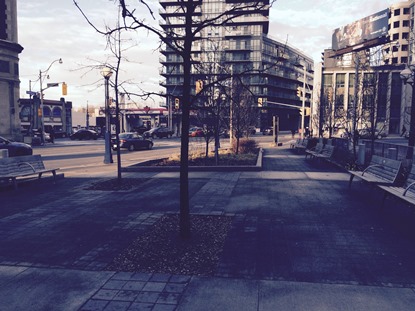Davenport Road
Ancient Trail Binawiigo Bimikawewin
Beneath the winding course of Davenport Road lies hidden an ancient trail created by Aboriginal peoples. The trail linked their settlements with hunting and fishing grounds, and with trade routes that tied this region to the upper Great Lakes, the Atlantic coast, and the Midwest.
The ancient trail beneath Davenport Road may have become known to Europeans in the 1600s when French traders, missionaries, and soldiers entered this area. With the arrival of British settlers and the establishment un 1793 of the Town of York (now Toronto), the footpath was never transformed. The trail through the forests allowed travel to and from newly settled lands, and was eventually widened to accommodate horses and wagons. The new road was named Davenport after a house built on the escarpment for John McGill in 1797.
 |
| Frank Stollery Parkette, 1 Davenport Road. Photo : Elena |
Between the Humber and the Don Rivers, the ancient footpath avoided difficult terrain by weaving along the foot of the escarpment that is one of Toronto`s most distinctive geological features. It was the shoreline of 13,500-year-old glacial Lake Iroquois, forerunner of much smaller Lake Ontario. This meandering route, at odds with the city`s rectangular street grid, now connects us with the distant past.
Stroll in the Parkette of Davenport Road to learn more about Davenport Road`s evolution into a city street.
As the forest along its length was cleared for farms and industry, the ancient trail beneath Davenport Road became an important link to small villages such as Yorkville and Carlton, and to the City of Toronto`s markets. Beginning in the 1830s, the former Lake Iroquois deposits of gravel, clay, and sand were transported along Davenport Road for the building of the city.
 |
| Davenport Road. Photo by Elena |
Paved in one section with wooden planks in the mid-19th century, Davenport Road featured toll booths at its major intersections to finance the roadwork – one has survived at Bathurst Street, and is now a museum. By the 1890s, an electric street railway ran along Davenport west from Bathurst. Since the 1930s, increased automobile traffic has led to further widening of the road.
Created by ancient peoples, the Davenport Road route is today a busy urban thoroughfare.
No comments:
Post a Comment
You can leave you comment here. Thank you.